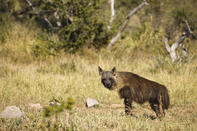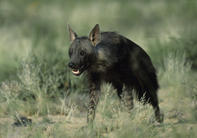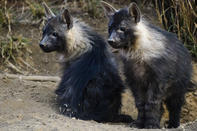The brown hyena (Hyena brunnea) is also called a strandwolf – an Afrikaans word meaning “beach wolf” when directly translated into English – because of its habit of strolling along beaches in search of food.

They are the third largest hyena species and can be distinguished from other hyenas by their long shaggy hair, which is dark brown or black on the body and lighter coloured on the neck and shoulders. Adults grow 130 cm to 160 cm long, with males weighing 47 kg and females around 42 kg on average.
The forelegs of brown hyena are horizontally striped and much longer than their more massively built hind legs, resulting in their shoulders being higher than their rumps. Their heads are large with less hair than the rest of their body and they have long pointed ears.
Brown hyena usually live in clans consisting of four to twenty individuals, but some males and females may turn into solitary nomads. Females either mate with a dominant alpha male, or nomadic males that venture into the clan’s territory. Nomadic males usually locate sexually receptive females by sense of smell, using territorial scent markings and latrine sights made by the clan.
Brown hyena become sexually mature from about two and a half years of age. The mating season is usually from May to August, depending on the availability of food.
Females give birth in isolated dens and and a few weeks later, move their young to the rest of the clan. About one to five pups are born after a gestation period of up to 100 days. They will drink from the mother up to fourteen months of age.
Killing and Feeding Pattern

Brown hyenas are primarily scavengers, eating a wide variety of small vertebrates, insects and fruits. They usually forage alone, but several animals even from different clans may gather to feed on a large carcass. They are most active at night, but become more active in the day, when food is scarce.
They are poor hunters, so live prey make up a very small portion of their diet. Individuals may, however, sometimes turn into stock thieves. Farmers should remember that seeing a brown hyena feeding on a carcass does not necessarily mean that they have killed the animal.
The Predation Management Forum's manual, describes prey as being caught from behind, brought down and then killed by either crushing the head with their powerful jaws, a bite at the back of the skull that crushes and opens the brains or a bite on the side of the neck, with one tooth close to the eye of the prey and the other at the base of the throat.
Young animals will be completely devoured, while only a part of the rib cage may be left if the prey is bigger. The skull or large bones of the prey may have been crushed. The intestines are seldom eaten.
Management

“Looking after” brown hyenas may actually have positive spin-offs, since competition with other small predators such as jackal may help to curb livestock losses. On hunting farms, they also play a valuable role in preventing the spread of diseases by cleaning up carrion.
A permit is required to catch and release brown hyena, since they are the rarest of the hyena family, listed as near threatened by the International Union of Conservation of Nature.
Using a leopard cage trap with a lamb carcass as bait can be used relatively successfully to trap brown hyena. Electric fencing is one of the best ways to keep spotted hyena away from livestock, while kraaling, shepherds and guard animals can be used to protect animals from predation from brown hyenas.
By Glenneis Kriel